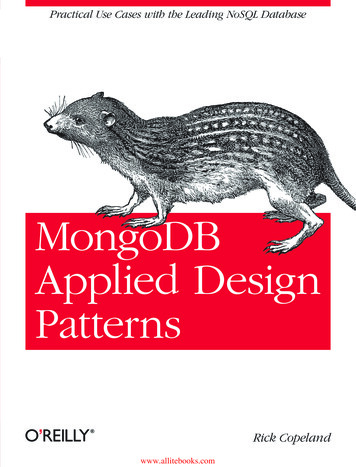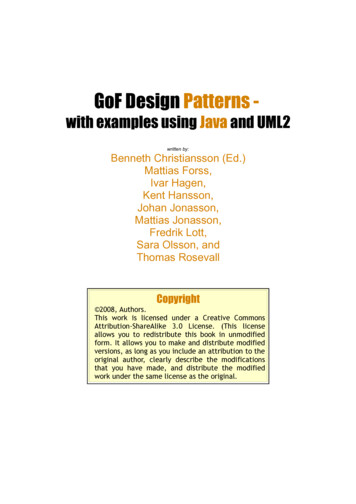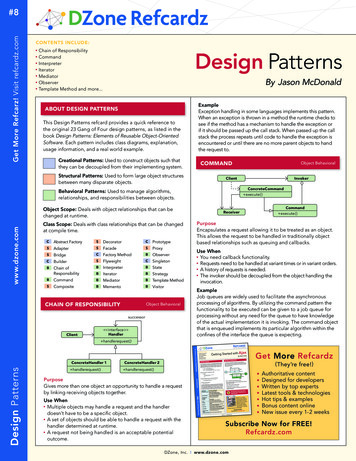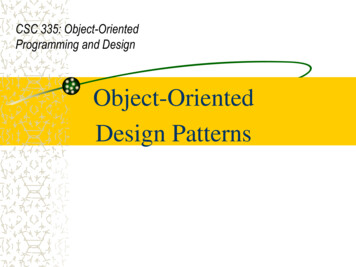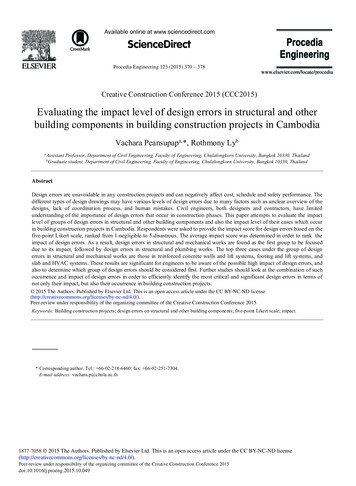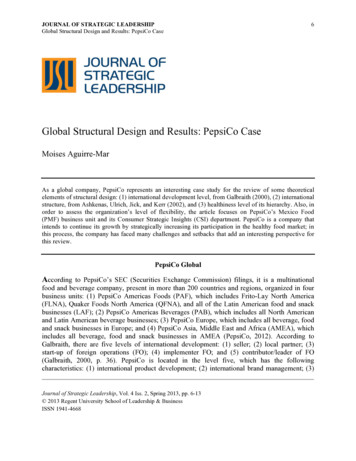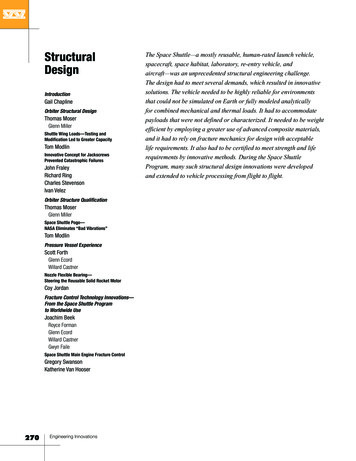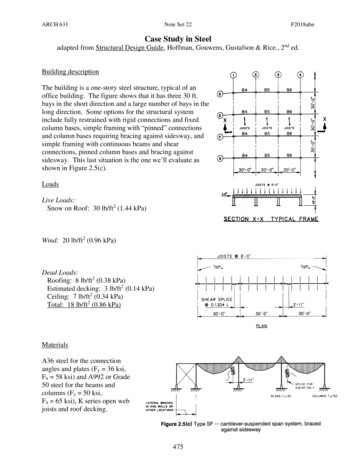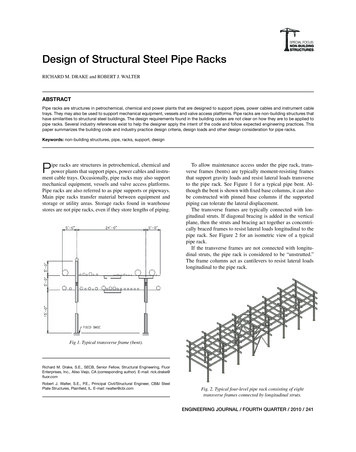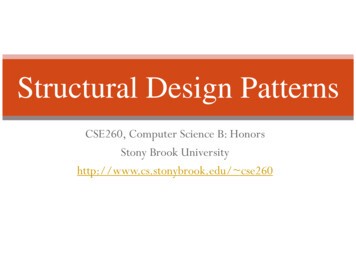
Transcription
Structural Design PatternsCSE260, Computer Science B: HonorsStony Brook Universityhttp://www.cs.stonybrook.edu/ cse260
Structural Design Patterns Design patterns that ease the design by identifying a simple way to realizerelationships between entities. Decorator pattern: adds additional functionality to a class at runtimewhere subclassing would result in an exponential rise of new classes. Adapter pattern: "adapts" one interface for a class into one that a clientexpects. Facade pattern: creates a simplified interface of an existing interface toease usage for common tasks. Flyweight pattern: a high quantity of objects share a common propertiesobject to save space. Bridge pattern: decouples an abstraction from its implementation sothat the two can vary independently.2(c) Paul Fodor & O'Reilly Media
Common Design PatternsCreational Factory Singleton Builder Prototype3Structural Decorator Adapter Facade Flyweight BridgeBehavioral Strategy Template Observer Command Iterator StateTextbook: Head First Design Patterns(c) Paul Fodor & O'Reilly Media
The Decorator Pattern Attaches additional responsibilities to an objectdynamically. i.e. decorating an object Decorators provide a flexible alternative to subclassing for extending functionality. How? By wrapping an object Works on the principle that classes should beopen to extension but closed to modification.4(c) Paul Fodor & O'Reilly Media
Decorator Goal Allow classes to be easily extended toincorporate new behavior withoutmodifying existing code. What do we get if we accomplish this? Designs that are resilient to change andflexible enough to take on newfunctionality to meet changingrequirements.5(c) Paul Fodor & O'Reilly Media
6(c) Paul Fodor & O'Reilly Media
ClassExplosion(c) Paul Fodor & O'Reilly Media
One Solution: Add instance variables to represent whetheror not each beverage has milk, soy, mocha and whip.Problem: thiscannot change inthe future. ForHalloween, wewant to addpumpkin spice. ForThanksgiving, wewant to addcinnamon. ForChristmas, 8(c) Paul Fodor & O'Reilly Media
Decorator pattern We’ll start with a beverage and "decorate" it with the condimentsat runtime. For example, if the customer wants a Dark Roast with Mocha andWhip, then we’ll:1. Take a DarkRoast object.2. Decorate it with a Mocha object.3. Decorate it with a Whip object.4. Call the cost() method and rely on delegation to add on thecondiment costs.9(c) Paul Fodor & O'Reilly Media
Decorators Override Functionality10(c) Paul Fodor & O'Reilly Media
11(c) Paul Fodor & O'Reilly Media
public abstract class Beverage {String description "Unknown Beverage";public String getDescription() {return description;}public abstract double cost();}public class HouseBlend extends Beverage {public HouseBlend() {description "HouseBlend";}public double cost() {return 1.99;}}public abstract class CondimentDecorator extends Beverage {protected Beverage beverage;public abstract String getDescription();}public class Mocha extends CondimentDecorator {public Mocha(Beverage beverage) {this.beverage beverage;}public String getDescription() {return beverage.getDescription() ", Mocha";}public double cost() {return 0.20 12beverage.cost();}}(c) Paul Fodor & O'Reilly Media
public class StarbuzzCoffee {public static void main(String args[]) {Beverage beverage new ption() " " beverage.cost());Beverage beverage2 new Mocha(beverage);beverage2 new Sugar(beverage2);beverage2 new Whip(beverage2);beverage2 new scription() " " beverage2.cost());Beverage beverage3 new Soy(new Mocha(new Whip(new scription() " " beverage3.cost());}}13(c) Paul Fodor & O'Reilly Media
Java’s IO Library14(c) Paul Fodor & O'Reilly Media
// The Window interface classpublic interface Window {public void draw(); // Draws the Windowpublic String getDescription(); // Returns a description}// Extension of a simple Window without any scrollbarsclass SimpleWindow implements Window {public void draw() {// Draw window}public String getDescription() {return "simple window";}}// abstract decorator class - it implements Windowabstract class WindowDecorator implements Window {protected Window windowToBeDecorated;public WindowDecorator (Window windowToBeDecorated) {this.windowToBeDecorated windowToBeDecorated;}public void draw() {windowToBeDecorated.draw(); //Delegation}15(c) Paul Fodor & O'Reilly Media
public String getDescription() {return }// The first concrete decorator - adds vertical scrollbarclass VerticalScrollBarDecorator extends WindowDecorator {public VerticalScrollBarDecorator(Window Overridepublic void draw() {super.draw();drawVerticalScrollBar();}private void drawVerticalScrollBar() {// Draw the vertical scrollbar}@Overridepublic String getDescription() {return super.getDescription() ", including vertical scrollbars";}}16(c) Paul Fodor & O'Reilly Media
// The second concrete decorator - adds horizontal scrollbarclass HorizontalScrollBarDecorator extends WindowDecorator {public HorizontalScrollBarDecorator(Window Overridepublic void draw() {super.draw();drawHorizontalScrollBar();}private void drawHorizontalScrollBar() {// Draw the horizontal scrollbar}@Overridepublic String getDescription() {return super.getDescription() ", including horizontal scrollbars";}}17(c) Paul Fodor & O'Reilly Media
public class DecoratedWindowTest {public static void main(String[] args) {// Create a decorated Window with horizontal and// vertical scrollbarsWindow decoratedWindow new HorizontalScrollBarDecorator(new VerticalScrollBarDecorator(new SimpleWindow()));// Print the Window's escription());}}The output of this program is "simple window, including verticalscrollbars, including horizontal scrollbars" (each decoratordecorates the window description with a suffix).18(c) Paul Fodor & O'Reilly Media
Common Design PatternsCreational Factory Singleton Builder Prototype19Structural Decorator Adapter Facade Flyweight BridgeBehavioral Strategy Template Observer Command Iterator StateTextbook: Head First Design Patterns(c) Paul Fodor & O'Reilly Media
Ever been to Europe, Asia or Australia? You need adaptors (sometimes transformers:)20(c) Paul Fodor & O'Reilly Media
The Adapter Pattern Converts the interface of a class into anotherinterface a client expects Adapter lets classes work together that couldn’totherwise because of incompatible interfaces Do you know what a driver is?21(c) Paul Fodor & O'Reilly MediaDevice drivers.
Object oriented adapters You have an existing system You need to work a vendor library into the system The new vendor interface is different from the lastvendor You really don’t want to and should not changeyour existing system Solution: Make a class that adapts the new vendorinterface into what the system uses.22(c) Paul Fodor & O'Reilly Media
23(c) Paul Fodor & O'Reilly Media
How do we do it? Example: Driver Existing system uses a driver via an interface New hardware uses a different interface Adapter can adapt differences Existing system HAS-A OldInterface Adapter implements OldInterface and HAS-ANewInterface Existing system calls OldInterface methods onadapter, adapter forwards them to NewInterfaceimplementations24(c) Paul Fodor & O'Reilly Media
What’s good about this? Decouple the client from the implementedinterface If we expect the interface to change overtime, the adapter encapsulates that change sothat the client doesn’t have to be modifiedeach time it needs to operate against adifferent interface.25(c) Paul Fodor & O'Reilly Media
public interface Duck {// old classvoid quack();void walk();}public class MallardDuck implements Duck {@Overridepublic void quack() {System.out.println("Quack. quack.");}@Overridepublic void walk() {System.out.println("Walking duck .");}}public class Main {public static void main(String[] args) {System.out.println("Duck: ");Duck duck new MallardDuck();test(duck);}static void test(Duck duck) {duck.quack();duck.walk();}26}(c) Paul Fodor & O'Reilly Media
27public class Turkey {public void walk() {// A new classSystem.out.println("Walking turkey .");}public void gobble() {System.out.println("Gobble . gobble .");}}public class TurkeyAdapter implements Duck {private Turkey turkey;public TurkeyAdapter(Turkey turkey) {this.turkey turkey;}@Overridepublic void quack() {turkey.gobble();}@Overridepublic void walk() {turkey.walk();}}public class Main {public static void main(String[] args) {System.out.println("Fake duck (i.e., turkey): ");Duck x new TurkeyAdapter(new Turkey());test(x);}static void test(Duck duck) {duck.quack();duck.walk();(c) Paul Fodor & O'Reilly Media}}
Common Design PatternsCreational Factory Singleton Builder Prototype28Structural Decorator Adapter Facade Flyweight BridgeBehavioral Strategy Template Observer Command Iterator StateTextbook: Head First Design Patterns(c) Paul Fodor & O'Reilly Media
The Facade Pattern Provides a unified interface to a set ofinterfaces in a subsystem. The facade defines a higher-level interface thatmakes the subsystem easier to use Employs the principle of "least knowledge"29(c) Paul Fodor & O'Reilly Media
30(c) Paul Fodor & O'Reilly Media
Scenario: Watching a movie Steps (very complicated):1. Put the screen down2. Turn the projector on3. Set the projector input to DVD4. Put the projector on wide-screen mode5. Turn the sound amplifier on6. Set the amplifier to DVD input7. Set the amplifier to surround sound8. Set the amplifier volume to medium (5)9. Turn the DVD Player on10.Start the DVD Player playing11.Turn on the popcorn popper12.Start the popper popping3113.Dim the lights(c) Paul Fodor & O'Reilly Media
Scenario: Watching a movie Let’s do it programmatically:32(c) Paul Fodor & O'Reilly Media
The Facade Pattern When the movie is over, how do youturn everything off ? Wouldn’t you have to do all of thisover again, in reverse? If you decide to upgrade your system,you’re probably going to have to learn adifferent procedure.33(c) Paul Fodor & O'Reilly Media
TheFaçadePatternwatchMovie()endMovie()Abstract everything ina few methods:watchMovie()endMovie()34(c) Paul Fodor & O'Reilly Media
35public class HomeTheaterFacade {Amplifier amp;Tuner tuner;DvdPlayer dvd;CdPlayer cd;Projector projector;TheaterLights lights;Screen screen;.public HomeTheaterFacade(Amplifier amp, Tuner tuner, DvdPlayerdvd, CdPlayer cd, Projector projector, Screen screen,TheaterLights lights, .) { . }public void watchMovie(String movie) play(movie);}public void endMovie() ;dvd.stop();dvd.eject(); .(c)}Paul Fodor & O'Reilly Media
public class Main {public static void main(String[] args) {HomeTheaterFacade facade new HomeTheaterFacade(new Amplifier(),new Tuner(),new DvdPlayer(),new CdPlayer(),new Projector(),new Screen(),new TheaterLights(),.);facade.watchMovie("Action in Space");facade.endMovie();}}36(c) Paul Fodor & O'Reilly Media
// Computers are complicatedclass CPU {public void freeze() { . }public void jump(long position) { . }public void execute() { . }}class Memory {public void load(long position, byte[] data) { . }}37class HardDrive {public byte[] read(long lba, int size) { . }}/* Facade */public static void main(String[] args) {class ComputerFacade {ComputerFacade computer private CPU processor;new ComputerFacade();private Memory ram;computer.start();private HardDrive hd;}public ComputerFacade() {this.processor new CPU();this.ram new Memory();this.hd new HardDrive();}public void start() {processor.freeze();ram.load(BOOT ADDRESS, hd.read(BOOT SECTOR, SECTOR SIZE));processor.jump(BOOT ADDRESS);processor.execute();} }(c) Paul Fodor & O'Reilly Media
Quiz: Which is which? Converts one interface to another Makes an interface simpler Doesn’t alter the interface, but addsresponsibilityA) DecoratorB) AdapterC) Facade38(c) Paul Fodor & O'Reilly Media
Quiz: Which is which? Converts one interface to another B Makes an interface simpler C Doesn’t alter the interface, but addsresponsibility AA) DecoratorB) AdapterC) Facade39(c) Paul Fodor & O'Reilly Media
Common Design PatternsCreational Factory Singleton Builder Prototype40Structural Decorator Adapter Facade Flyweight BridgeBehavioral Strategy Template Observer Command Iterator StateTextbook: Head First Design Patterns(c) Paul Fodor & O'Reilly Media
Flyweight scenario You develop a landscape design application for Stony Brook: After using your software for a week, your client41is complaining that when they create large grovesof trees, the app starts getting sluggish.(c) Paul Fodor & O'Reilly Media
Flyweight scenario Flyweight: only one instance of Tree, and a clientobject that maintains the state of ALL the trees.42(c) Paul Fodor & O'Reilly Media
The Flyweight Pattern A "neat hack" Allows one object to be used to represent manyidentical instances The Flyweight is used when a class has many instances, and they can allbe controlled identically. Flyweight Benefits: Reduces the number of object instances at runtime, saving memory. Centralizes state for many "virtual" objects into a single location. Flyweight Uses and Drawbacks: Once you’ve implemented it, single, logical instances of the class will notbe able to behave independently from the other instances.43(c) Paul Fodor & O'Reilly Media
The Flyweight Pattern Flyweights must be immutable. Flyweights depend on an associated table maps identical instances to the single object thatrepresents all of them Used in processing many large documents search engines a document as an array of immutable Strings repeated words would share objects just one object referenced all over the place use static Hashtable to store mappings44(c) Paul Fodor & O'Reilly Media
import java.util.ArrayList;import java.util.HashMap;import java.util.List;import java.util.Map;// Instances of CoffeeFlavour will be the Flyweightsclass CoffeeFlavour {private final String name;CoffeeFlavour(String newFlavor) {this.name newFlavor;}@Overridepublic String toString() {return name;}}// Menu acts as a factory and cache for CoffeeFlavour flyweight objectsclass Menu {private Map String, CoffeeFlavour flavours new HashMap String,CoffeeFlavour ();CoffeeFlavour lookup(String flavorName) {if avorName, new CoffeeFlavour(flavorName));return flavours.get(flavorName);}int totalCoffeeFlavoursMade() {return flavours.size();45(c) Paul Fodor & O'Reilly Media}You have acoffee shop
class Order {private final int tableNumber;private final CoffeeFlavour flavour;Order(int tableNumber, CoffeeFlavour flavor) {this.tableNumber tableNumber;this.flavour flavor;}void serve() {System.out.println("Serving " flavour " to table " tableNumber)}}public class CoffeeShop {private final List Order orders new ArrayList Order ();private final Menu menu new Menu();void takeOrder(String flavourName, int table) {CoffeeFlavour flavour menu.lookup(flavourName);Order order new Order(table, flavour);orders.add(order);}void service() {for (Order order : orders)order.serve();}String report() {return "\ntotal CoffeeFlavour objects made: " menu.totalCoffeeFlavoursMade();46(c) Paul Fodor & O'Reilly Media}
public static void main(String[] args) {CoffeeShop shop new CoffeeShop();shop.takeOrder("Cappuccino", 2);shop.takeOrder("Frappe", 1);shop.takeOrder("Espresso", 1);shop.takeOrder("Frappe", 897);shop.takeOrder("Cappuccino", 97);shop.takeOrder("Frappe", 3);shop.takeOrder("Espresso", 3);shop.takeOrder("Cappuccino", 3);shop.takeOrder("Espresso", 96);shop.takeOrder("Frappe", 552);shop.takeOrder("Cappuccino", 121);shop.takeOrder("Espresso", ());}Output:Serving Cappuccino to table 2Serving Frappe to table 1Serving Espresso to table 1Serving Frappe to table 897Serving Cappuccino to table 97Serving Frappe to table 3Serving Espresso to table 3Serving Cappuccino to table 3 .47(c) Paul Fodor & O'Reilly Media
Common Design PatternsCreational Factory Singleton Builder Prototype48Structural Decorator Adapter Facade Flyweight BridgeBehavioral Strategy Template Observer Command Iterator StateTextbook: Head First Design Patterns(c) Paul Fodor & O'Reilly Media
The Bridge Pattern Used to vary not only your implementations, but alsoyour abstractions! Scenario: you’re writing the code for a new ergonomic and userfriendly remote control for TVs there will be lots of implementations – one for eachmodel of TV – use an abstraction (interface) you know there will be many changes over time to thespecification – needs to accommodate changes Solution? Abstract the abstraction!49(c) Paul Fodor & O'Reilly Media
Scenario A bridge-less design Won’t easilyaccommodatechange50(c) Paul Fodor & O'Reilly Media
This is better51(c) Paul Fodor & O'Reilly Media
The Bridge Pattern Bridge Benefits Decouples an implementation so that it is not boundpermanently to an interface. Abstraction and implementation can be extendedindependently. Useful in graphics and windowing systems that need to runover multiple platforms. Useful any time you need to vary an interface and animplementation in different ways. Bridge Drawback: Increases complexity.52(c) Paul Fodor & O'Reilly Media
/** "Abstraction" */abstract class Shape {protected DrawingAPI drawingAPI;protected Shape(DrawingAPI drawingAPI){this.drawingAPI drawingAPI;}public abstract void draw();public abstract void resizeByPercentage(double pct);}/** "Refined Abstraction" */class CircleShape extends Shape {private double x, y, radius;public CircleShape(double x, double y, double radius,DrawingAPI drawingAPI) {super(drawingAPI);this.x x; this.y y; this.radius radius;}// low-level i.e. Implementation specificpublic void draw() {drawingAPI.drawCircle(x, y, radius);}// high-level i.e. Abstraction specificpublic void resizeByPercentage(double pct) {radius * pct;}}53(c) Paul Fodor & O'Reilly Media// low-level// high-level
/** "Implementor" */interface DrawingAPI {public void drawCircle(double x, double y, double radius);}/** "ConcreteImplementor" 1 */class DrawingAPI1 implements DrawingAPI {public void drawCircle(double x, double y, double radius) {System.out.printf("API1.circle at %f:%f radius %f\n", x, y, radius);}}/** "ConcreteImplementor" 2 */class DrawingAPI2 implements DrawingAPI {public void drawCircle(double x, double y, double radius) {System.out.printf("API2.circle at %f:%f radius %f\n",x,y,radius);}}/** "Client" */public class BridgePattern {public static void main(String[] args) {Shape[] shapes new Shape[] {new CircleShape(1, 2, 3, new DrawingAPI1()),new CircleShape(5, 7, 11, new DrawingAPI2()),};for (Shape shape : shapes) ;API1.circle at 1.0:2.0 radius 7.554(c) Paul Fodor & O'Reilly Media}}}API2.circle at 5.0:7.0 radius 27.5
(c) Paul Fodor & O'Reilly Media Structural Design Patterns Design patterns that ease the design by identifying a simple way to realize relationships between entities. Decorator pattern: adds additional functionality



